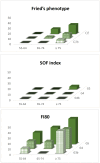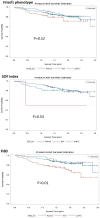Frailty predicts adverse clinical outcomes in patients with moderate to severe chronic kidney disease
- PMID: 40240291
- PMCID: PMC12074821
- DOI: 10.18632/aging.206239
Frailty predicts adverse clinical outcomes in patients with moderate to severe chronic kidney disease
Abstract
Background and aim: Frailty predicts adverse clinical outcomes in older adults. Its prognoses in individuals with specific illnesses have not been fully explored. This study aimed to investigate the impact of frailty by using a semiautomated instrument in patients with advanced chronic kidney disease (CKD).
Methods and results: In this prospective study, patients with CKD3b-5 before dialysis and aged ≥55 years with a clinical frailty scale of ≤5 were enrolled. Frailty was assessed by three commonly-used evaluation tools, i.e., Fried's frailty phenotype, Study of Osteoporotic Fractures (SOF) index, and Frailty index of 80 risk variables (FI80) incorporated in a semiautomated platform. Logistic regression, Kaplan-Meier analysis, and Cox proportional hazards models were used to analyze the predictors for frailty and the impact of frailty on composite outcomes of dialysis and overall death. Among 315 patients, the mean age was 73.1 years, and the estimated glomerular filtration rate was 22.2 ml/min/1.73 m2. The prevalence of frailty was 6.2% by Fried's frailty phenotype, 0.6% by SOF index, and 26.7% by FI80. Logistic regression analysis showed that age, but not CKD severity or proteinuria, was the most consistent predictor for frailty across the three evaluative tools. During an average follow-up period of 1.7 years, the incidences of kidney failure resulting in dialysis, overall death, or hospital admission were 10.5, 0.6, and 15.2 per 1,000 patient-month, respectively. Kaplan-Meier analysis revealed that frail patients identified by FI80 exhibited worse composite outcomes than their prefrail and robust counterparts (log-rank test, P = 0.01). Multivariate Cox models confirmed that frailty defined by FI80 predicted adverse composite outcomes (HR 3.51, 95% CI: 1.20, 10.22).
Conclusions: Frailty is common among CKD patients, and its prevalence increases with age and disease advancement. The frailty status identified by the FI80 effectively predicted end-stage kidney disease or death in patients with advanced CKD.
Keywords: Fried’s frailty phenotype; SOF index; chronic kidney disease; frailty; frailty index.
Conflict of interest statement
Figures
References
-
- Tao Z, Liu S, Li B. Correlation Study of Frailty and Depression in elderly patients with Chronic Kidney Disease. 11th International Conference on Information Technology in Medicine and Education (ITME). Wuyishan, Fujian, China. 2021; 412–415. 10.1109/ITME53901.2021.00089 - DOI
-
- Fried LP, Tangen CM, Walston J, Newman AB, Hirsch C, Gottdiener J, Seeman T, Tracy R, Kop WJ, Burke G, McBurnie MA, and Cardiovascular Health Study Collaborative Research Group. Frailty in older adults: evidence for a phenotype. J Gerontol A Biol Sci Med Sci. 2001; 56:M146–56. 10.1093/gerona/56.3.m146 - DOI - PubMed
-
- Ensrud KE, Ewing SK, Taylor BC, Fink HA, Cawthon PM, Stone KL, Hillier TA, Cauley JA, Hochberg MC, Rodondi N, Tracy JK, Cummings SR. Comparison of 2 frailty indexes for prediction of falls, disability, fractures, and death in older women. Arch Intern Med. 2008; 168:382–9. 10.1001/archinternmed.2007.113 - DOI - PubMed
MeSH terms
LinkOut - more resources
Full Text Sources
Medical




